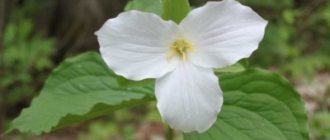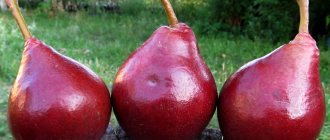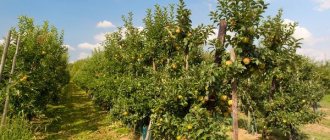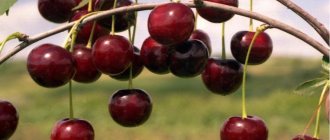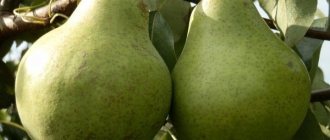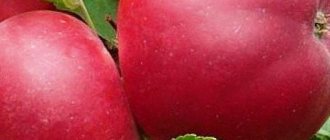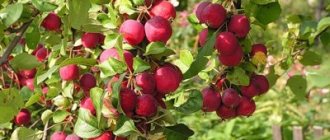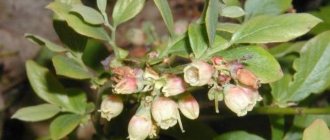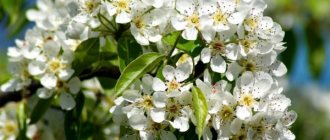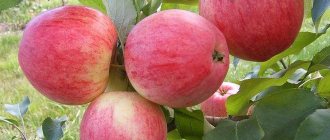History of the variety's creation
The Duchess variety was bred in 1796 by the British breeder Wheeler. The name translates as "duchess". Unfortunately, during the life of the breeder, the culture did not become popular, but now this plant is found all over the world, since everyone likes the very tasty and aromatic fruits. Gardeners also love Duchess because it is not difficult to grow. It only needs a lot of light and warmth to produce an excellent harvest.
The only caveat is that the pear must ripen on the tree. If you pick it ahead of time, it will cease to be tasty and aromatic, and its shelf life is significantly reduced.
Features of cultivation in different regions of Russia
Duchess varieties are not zoned throughout the entire territory of the Russian Federation. When selecting a pear, the following principles are taken into account:
- Growing Angoulême is preferable in the Caucasus and Crimea. Northern areas are not suitable.
- Moscow Wild variety is suitable for different regions: Central Asia, the Caucasus, the Moscow region.
- The Moscow Garden variety is suitable for the Moscow region, as well as the European part of the country.
- The winter variety is planted in Crimea, the Caucasus, and Uzbekistan.
- Summer Duchess is cultivated in the southern regions.
Characteristics and varieties of the variety
Duchess is the favorite pear of amateur gardeners. The plant produces a rich harvest with little care. The fruits are very juicy and sweet, have a thin skin. Many people use them for homemade preparations.
Duchess summer pear variety
It is completely unpretentious to environmental conditions, so it lives in any soil. Tree size is up to 4 meters. The crown has the appearance of a wide pyramid. The taste of the fruit is very pleasant. This variety is characterized by high resistance to scab, but is afraid of aphids and copperheads.
Flowers on the branches form quite late and remain for a long time. They are collected in inflorescences. The first harvest should be expected 5-6 years after planting the tree.
The fruits are medium or large in size, weight can reach 200 grams. From an adult individual of such a pear you can harvest from 160 to 260 kilograms of harvest. The fruits themselves are elongated, their surface is uneven and wavy, the skin is thin and shiny, and the smell is sweetish.
The summer variety has a very pleasant taste with musky notes. The pulp melts in the mouth, leaving a pleasant aftertaste. Tasting score – 4.8 points.
You can harvest this pear from the second ten days of August. Fruits can be stored for a very short time, about two weeks. If you maintain the temperature at 5 degrees Celsius, the shelf life will last up to a month. Can be consumed fresh or dried, made into compote or jam.
Pear pollinators
This variety is not self-fertile; pollinators are needed to set fruit. It is necessary to plant varieties with approximately the same flowering time nearby. Examples of good pollinators:
- Forest Beauty;
- Bere Bosc;
- Kappa's favorite;
- Williams Bon-Chrétien.
Forest Beauty
Bere Bosc
Kappa's pet
Williams Bon-Chrétien
Advantages and disadvantages of summer variety
The main advantages of this variety:
- the fruits are pleasant to look at;
- does not require special growing conditions;
- the taste is bright and pleasant;
- pears can be stored, although not for too long;
- the purpose of the pear is universal;
- the yield is good.
Main disadvantages:
- fruits adored by aphids and carnival, so the tree needs regular processing;
- pear needs pollinators;
- Fruiting begins quite late.
Interesting fact: on dry soils there is a higher sugar content in fruits. Therefore, it is advisable to place the tree on a hill and not water it too often.
Winter pear variety Duchess
This pear was brought from Belgium. The quality of the fruits resembles the summer variety, but their ripening time is somewhat later, and their resistance to cold is higher. The plant is not demanding on environmental conditions, but loves fertile and light soil, hills that are warmed by the sun.
Fruits may lose their characteristic taste, and also suffer from scab during rains and cold weather. It is worth noting that the tree cannot self-pollinate, so other varieties must be placed nearby for pollination. The following can be used as pollinators:
- Bere Ardanpont;
- Williams;
- Olivier de Sar.
Bere Ardanpont
Williams
Olivier de Sar
The crop produces its first harvest seven years after planting. Cleaning takes place in the second ten days of October. The frost resistance of the winter Duchess pear is very high.
The crop is distinguished by its yield; one adult individual can produce about 100 kilograms of pears. If you put the crop in the cold (about -1 degree), it will be stored for a long time, even until spring.
The ripe fruit is large in size, weighing up to 500 grams. The skin is yellow, flushed and smooth. The honey pulp, filled with juice, has a characteristic aroma with a slight sourness. You can eat it fresh, or you can make marmalade, candied fruits, compotes, wines, and so on.
Advantages and disadvantages of winter Duchess
- the fruits are large and have excellent commercial characteristics;
- the harvest can be stored for quite a long time;
- the yield is good;
- the plant is not afraid of frost.
Disadvantages of winter Duchess:
- needs pollinators;
- afraid of scab.
Variety of Duchess - Angoulême pear
A variety resistant to winter cold. Usually grows in Crimea or the Caucasus. From one tree you can get up to 160 kilograms of harvest. The fruits ripen early, are large in size, and can weigh up to a kilogram. Ripening occurs in the first ten days of August. When stored in the cellar, the fruits retain their properties for about 4 months.
Wild Moscow Duchess
The tree is very tall and blooms in May. The flowers are collected in inflorescences, painted white with pink splashes, and bees really like them. The fruits are small or medium, reaching a weight of up to 400 grams. You can get about 250 kilograms of harvest from one plant. It grows in the Moscow region, the Caucasus, and the European part of Russia.
Origin of the species
This representative is a native Englishman. It was there in the 18th century. breeder Williams received the new product that made him famous. It is noteworthy that the word translated means “duchess”. And this is no coincidence: beauty, stateliness, aroma justify the name.
Currently grows on individual plots and commercial plantations. Due to its unpretentiousness, cultivation is possible not only in the southern, but also in the central regions of Russia.
To which regions is the variety more adapted?
Varieties of Duchess are not adapted to all regions of Russia. When choosing a specific pear option for subsequent cultivation, such patterns should be taken into account.
- D'Angoulême is best grown in the Crimea, as well as in the Caucasus. The northern regions are not suitable for it.
- Moscow Wild Duchess grows well in various regions, including Central Asia, the Moscow region, and the Caucasus.
- Moscow Garden variety grows well in the Moscow region and in the European part of the Russian Federation.
- The winter variety should be planted in the Caucasus or Crimea. It also grows well in Uzbekistan.
- Summer Duchess grows well in the southern regions.
Duchess can be grown indoors (in greenhouses) throughout the country. The variety will bear fruit.
Planting and care
It is best to plant young plants of both winter and summer Duchess in the second ten days of April. Experts advise to engage in planting activities before the buds bloom on the tree. The seedlings should not be deepened too much, otherwise they will die.
Please note: you cannot pour fresh manure into the planting hole; it burns the roots of the plant.
If the soil is not fertilized, you need to add black soil. The soil composition can be improved by adding compost with peat. A cone is formed from this mixture, after which the roots of the young pear are distributed there. The tree needs strong support to protect it from the wind. The garter is made in the shape of a figure eight so as not to damage the seedling.
A very important nuance of care is mulching. It protects the soil from negative climatic conditions and temperature changes. To do this, take weeds, good humus and straw.
Description of fruits
Pears are barrel-shaped and lumpy. Their weight reaches 300-400 grams. The skin is dense, which ensures long-term storage of the fruit. Pears have a bright lemon color. In the place where a lot of sun has fallen, a blush may appear. The pulp is white, sweet.
In order for the fruits to have a pronounced taste and aroma, they must ripen on the tree. Prematurely picked fruits have a less intense taste.
Care Tips
- Mulching is carried out in the fall before temperatures and rains drop.
- Pear pruning is done in the spring.
- In the first year of planting, it is advisable to reduce the lateral branches above the buds and the central stem side by a quarter.
- In the second year of planting, the central part of the pear is reduced by 25 centimeters. Side branches are cut to 5 centimeters.
- To protect the crop from wind and cold, it is closed for the winter. The bottom of the trunk is wrapped in cotton cloth and newspapers.
- The pear should be watered before and after spring flowering - two or three buckets for each year of the plant’s life. One watering is done in the first ten days of autumn.
- It is not recommended to feed Duchess in the first year, since the hole was improved during planting. Fertilizers are mostly applied in the fall. Mineral fertilizers need to be added every year:
- per square meter 20-30 grams of potassium chloride;
- 20-25 grams of superphosphate;
- 20-25 grams of saltpeter.
Organic matter is added once every three years at the rate of 5-8 kilograms per square meter. Circular holes are formed around the pear and fertilizing is added to a depth of 15-20 centimeters.
How to care
To get high yields from this pear variety, you need to take care of its proper care.
Pollination
The Duchess pear is a self-fertile tree (like the Simply Maria pear), as it needs a pollinator. The variety responds best to pollination by the following brethren:
- Forest beauty,
- Bere Ardapon,
- Clapp's favorite
- Pass Krassan,
- Olivier de Serres
- Bere Bosk.
Watering
And although the Duchess variety tolerates drought well, it is still necessary to moisten the soil. Watering is done before and after flowering every year. One tree requires 2-3 buckets of water. If there is increased drought, you can do another watering in the fall.
Top dressing
Pear Duchess responds positively to feeding. In the first year, you don’t need to add anything if the planting hole has been fertilized. But with the onset of autumn, you can add mineral fertilizer. Per 1 m2 there are 20-30 g of potassium chloride, 20 g of nitrate, 20 g of superphosphate. The nutrient mixture is introduced into circular holes that were dug near the tree. The depth of application of fertilizing is 15-20 cm. It will also be interesting to learn about how to care for the Bere pear.
On the video - how to care for a pear:
Pest Control
Duchess pear is often affected by a disease such as scab. This happens during the period of bud break and at the end of flowering. To combat the disease, you need to use 1% Bordeaux mixture. Affected leaves should be removed and burned. Treat the soil with 0.3% Nitrafen solutions.
The tree may also be affected by copperhead. It overwinters in fruit buds and fallen leaves. Treat trees before the buds open. It is necessary to spray fruit trees in the spring. For this it is necessary to use a drug such as Karbofos. For 10 liters of water there is 90 g of the drug. It will also be useful to learn about what pests exist in the Cathedral pear, and what means can be used to control it.
To remove honeydew larvae, it is necessary to use organophosphorus insecticides.
Diseases and pests
The plant has poor disease resistance. It suffers from aphids and copperheads. You will have to fight scab at the end of flowering. For treatment, use 0.5% copper infusion of oxychloride or 1% Bordeaux hexane. It is better to burn the fried leaves, and treat the soil near the tree with Nitrafen 0.3%.
To protect against honeyweed (before buds open), use “Oleocuprite” or “Karbofos”. It is recommended to protect mature pears from animals. Hares love the bark of the tree; a fence will help keep them away.
Pear care
When caring for pear trees, the gardener needs to pay attention to timely watering, periodic fertilizing and pruning of excess branches.
Watering
Irrigate the soil under the pear as it dries. The crop especially needs moisture before flowering, after the buds fall off, and also in the fall. At least 20 liters of liquid are added to the seedling. Use warm, settled water. 2-3 days after watering, the soil in the root circle is loosened. After this, air will penetrate more easily to the root system.
Have you tried Duchess summer pear?
Yes
No
Top dressing
If a pear is planted in fertile soil, no nutrients are added the following year. Later in the spring, nitrogen is used, which is necessary for shoot growth. During flowering and fruiting, potassium and phosphorus are used.
Nutrients are added to the moist soil. Otherwise, the root system may be damaged by burns from mineral salts.
Trimming
In the spring, before the sap begins to flow, pruning is done. In the first year, shoots are shortened by a quarter. Pruning is done above the bud. After this, the tree will begin to grow evenly. Subsequently, pruning is done so that the pear takes the shape of a truncated cone. The lower shoots should be longer than the upper branches. In addition, sanitary pruning is carried out. Remove dry, frozen and diseased branches.
Preparing for winter
Summer Duchess does not tolerate harsh winters. Therefore, the tree is carefully prepared for wintering. In mid-autumn, moisture-recharging irrigation is carried out. If there is a lot of moisture in the ground, the root system will survive frosts better. The bottom of the trunk is wrapped with paper or cotton cloth. The root circle is covered with a layer of mulching material.
Reviews of Duchess pear
Natalya, Moscow : we planted a Duchess pear tree in our dacha a long time ago. A few years after planting, our beauty began to delight us with fruits - huge, beautiful and incredibly tasty. Duchess quickly became my favorite variety. We grow a winter variety and harvest in the fall, and sometimes earlier. The harvest also performs well in storage and can be eaten until spring.
Alena, Kostroma : I have been growing Duchess on my plot for a long time. My grandmother planted the first tree about 50 years ago, and it still pleases us with its harvest. I really like the taste, but the aroma cannot be described in words. The plant hardly gets sick, does not require special care measures, and for me this is very important, since sometimes I don’t have time to take care of it. Every year we collect 5 or more buckets from several trees; winter varieties lie in the cellar until spring (although we usually eat them earlier). Very pleased with Duchess!
Advantages and disadvantages
Many gardeners prefer to plant the Duchess pear variety on their plots, as it has multiple advantages. The advantages of this variety include:
- Excellent taste and delightful aroma;
- Easy to care for;
- Attractive appearance of the fruit;
- High yield;
- Unpretentiousness to soil and climate;
- Does not require close care;
- The pruning process is not difficult;
- Scab resistance;
- Transportability;
- Can be used for recycling.
In addition to all the above positive properties of the Duchess variety, there are also negative aspects:
- Insufficient resistance to dry weather;
- Insufficient frost resistance;
- Poor self-pollination;
- They begin to bear fruit late;
- Subject to damage by copperhead and aphids.
